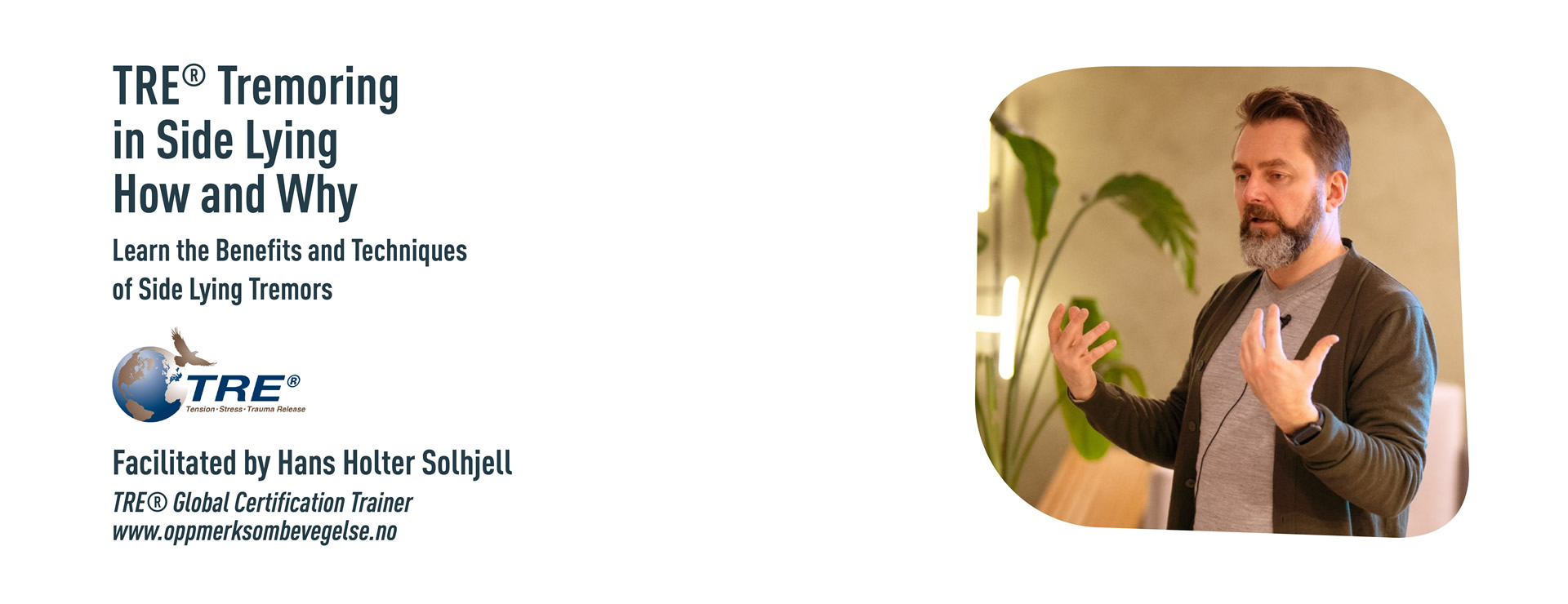
TRE® Course on Tremoring while Lying on the Side!
-TRE® tremoring while Lying on the Side part 1 -2
-Learn the Benefits and Techniques of Side Lying Tremors
This 2 part online course is a recording of a course with TRE® Global Certification Trainer Hans Holter Solhjell.
Welcome to this transformative TRE® course on Tremoring while Lying on the Side!
Many participants in TRE® courses primarily learn the basic positions in TRE and tremor only lying on their back. While this position is an excellent starting point for many patterns of tremors and movements, a typical TRE® session can involve a wide range of body movements, and not all are well-supported by the back-lying position.
Each position in TRE® facilitates certain patterns and movements while potentially hindering others. The side-lying position is particularly useful for understanding with regards to flexion and extension movements, rotational movements, as well as breath-related releases, crying etc. It also allows for a new set of hands-on interventions.
What You’ll Learn:
- Understanding the benefits of side-lying for different types of movements and emotional releases
- When to use the side lying position
- How to find and maintain a good position for side-lying tremoring
- Techniques to initiate and sustain tremors in both the lower and upper body while lying on the side
- Hands-on interventions to facilitate effective tremors in the side-lying position
Here are the benefits you can expect:
- Deeper Tremoring Experience: Learn more about the profound potential within the basic TRE® exercises..
- Embodied Integration: Deepen your practice of the exercises to promote embodied integration, allowing you to carry the benefits into your daily life.
- Safe and Balanced Practice: Learn how to increase your sense of embodied safety and integrated balance in your exercises and tremoring.
Course Benefits:
- Personal Empowerment: Gain tools to explore tremoring independently, fostering personal growth and self-awareness.
- Flexible Learning: Access course recordings through our online platform, offering the freedom to learn at your own pace and convenience.
Practical Details:
- Access Anywhere, Anytime: Enjoy the flexibility of viewing course recordings at your convenience, tailored to your schedule and personal preferences.
- Personal use only: This course is designed for personal use only, unless you are a certified TRE provider.
- Professional Application: If you’re a certified TRE® provider, integrate insights from this course into your work with clients and groups, enhancing your repertoire as an instructor.
- Acknowledgment: Certified TRE® providers can incorporate learnings into their professional practice, crediting TRE® and acknowledging David Berceli as the creator of TRE® and Hans Holter Solhjell as the creator of this course.
Unlock the potential within your tremoring practice.
Join us on this journey of self-discovery and empowerment.
Enroll now to begin your learning and exploration journey!
Price:
117 USD
Discount:
If you sign up for two of our online courses you will receive a 10% discount and for three online courses a 20% discount.
Requirements for buying and using this course.
This course is not for beginners in TRE. If you are a beginner you need to learn TRE first in an introduction course or in individual session. This course is only for those with significant experience with TRE, and using TRE by yourself. You need to have the experience that you can do TRE safely, and also be able to regulate well during and after sessions, an be able to relate to integrate emotions, memories etc that might arise.
Course Content:
Session 1:
- Understanding how different positions accommodate different tremor patterns
- Overview of side-lying position benefits, when and how
- Finding a comfortable and effective side-lying position for tremoring
- Demonstration of various ways to initiate tremors in the side lying position
- Group tremor with feedback
- Group observation of an individual tremoring.
- Q&A
Session 2:
- Sharing questions and experiences from between sessions
- Verbal interventions to support side lying tremors
- Hands-on interventions to support side-lying tremors
- Exploring flexion and extension movements in the side-lying position
- Group tremor with feedback
- Group observation of an individual tremoring.
- Q&A
